
Course Enrollment Trends at Harvard
How have enrollments in Harvard's most popular concentrations changed over time?
Introduction
As the Fall 2021 semester nears its end, it is fascinating to see how many undergraduates are actually enrolled in the same courses. After a year of online classes, the sizes of classes are now much more prominent when we can physically see crowds of students. The courses taught at Sanders Theatre are the most popular in terms of size: Ec10a and CS50 in particular have had enormous enrollment since at least 2017. It is therefore no surprise that during the 2019-2020 academic year, the two largest concentrations in the College were Economics and Computer Science. When exactly did these two fields of study claim their spots as popular concentrations? We wanted to investigate the College’s course enrollment records within the past decade in hopes of shedding light on these two concentrations’ presence in recent years.
Data
Through the Archived Course Enrollment Reports on the Registrar’s website, we have digital access to enrollment data for the courses offered every semester since Fall 1998. In this article, we focus on the academic years from 2011 to 2020. Due to technical inconsistencies with the presentation of certain semesters’ data, some of the earlier semesters, such as Spring 2012 and Spring 2013, are not included in this analysis.
Background
What does undergraduate course enrollment look like in the past decade?
For context, we looked at the total number of undergraduate students enrolled in the College alongside the total number of course enrollments since 2011.
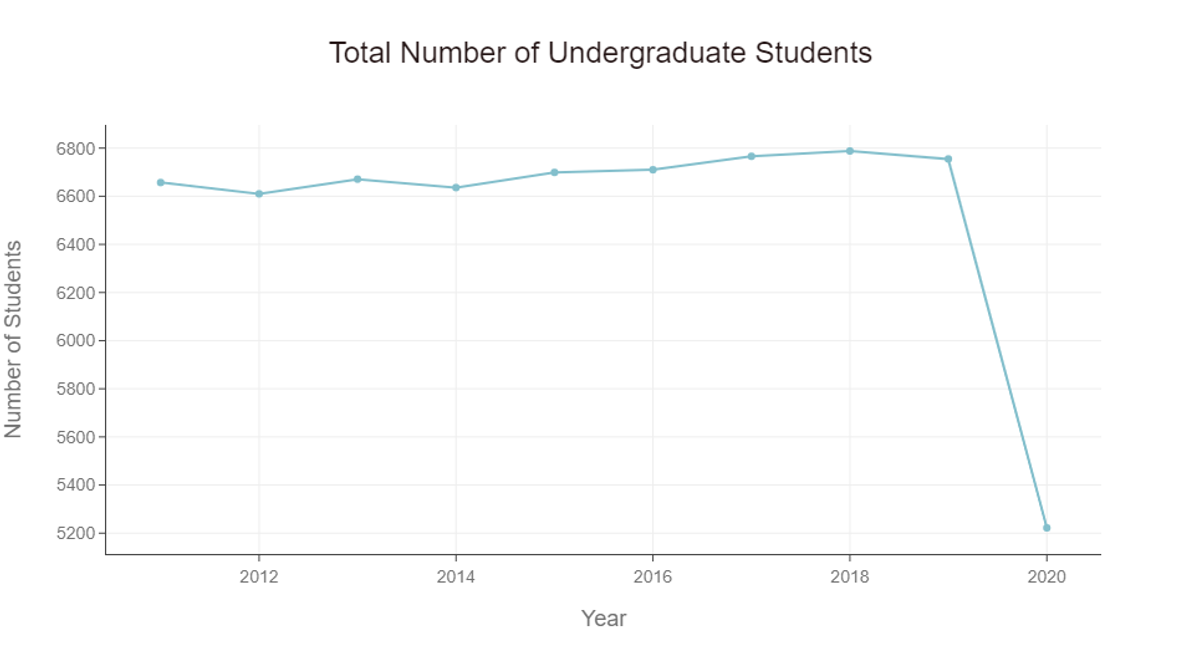 Total number of undergraduate students enrolled in the College from 2011 to 2020
Total number of undergraduate students enrolled in the College from 2011 to 2020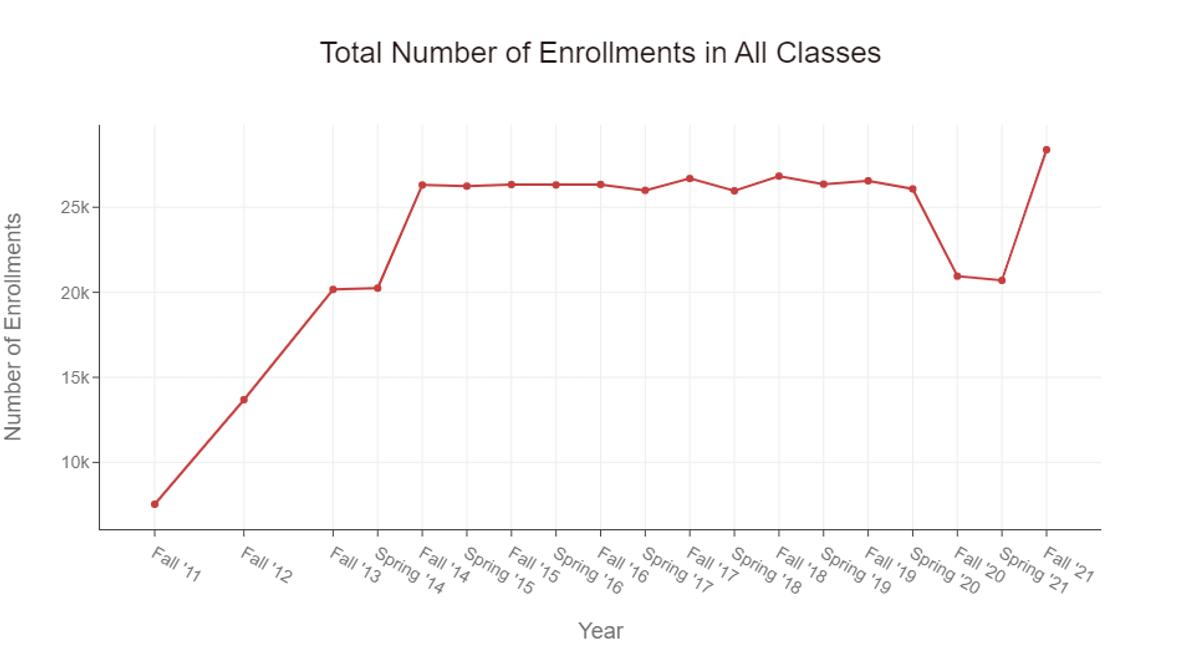 Total enrollment count across all courses offered during each semester, from Fall 2011 to Fall 2021 (excluding Spring 2012 and Spring 2013)
Total enrollment count across all courses offered during each semester, from Fall 2011 to Fall 2021 (excluding Spring 2012 and Spring 2013)We can see a sharp increase in enrollments from 2011 to 2014, followed by a consistent steady trend between 2014 and 2019. Since the undergraduate population size has stayed consistent from 2011 to 2019, students seem to be taking more classes since 2014 compared to 2011. During the pandemic, however, there were significantly fewer course enrollments (2020-2021 academic year). It is safe to assume that undergraduates (particularly first-years) taking leaves of absences or deferring their admission is the cause of this drop in course enrollment. This is highlighted by the drastic drop in undergraduate population for the 2020-2021 academic year. However, it is reassuring that Harvard students have resumed their high number of course enrollments after returning to campus, most likely due to the spike in undergraduate population in Fall 2021.
Computer Science Enrollment
We investigated the total number of enrollments in Computer Science courses in general.
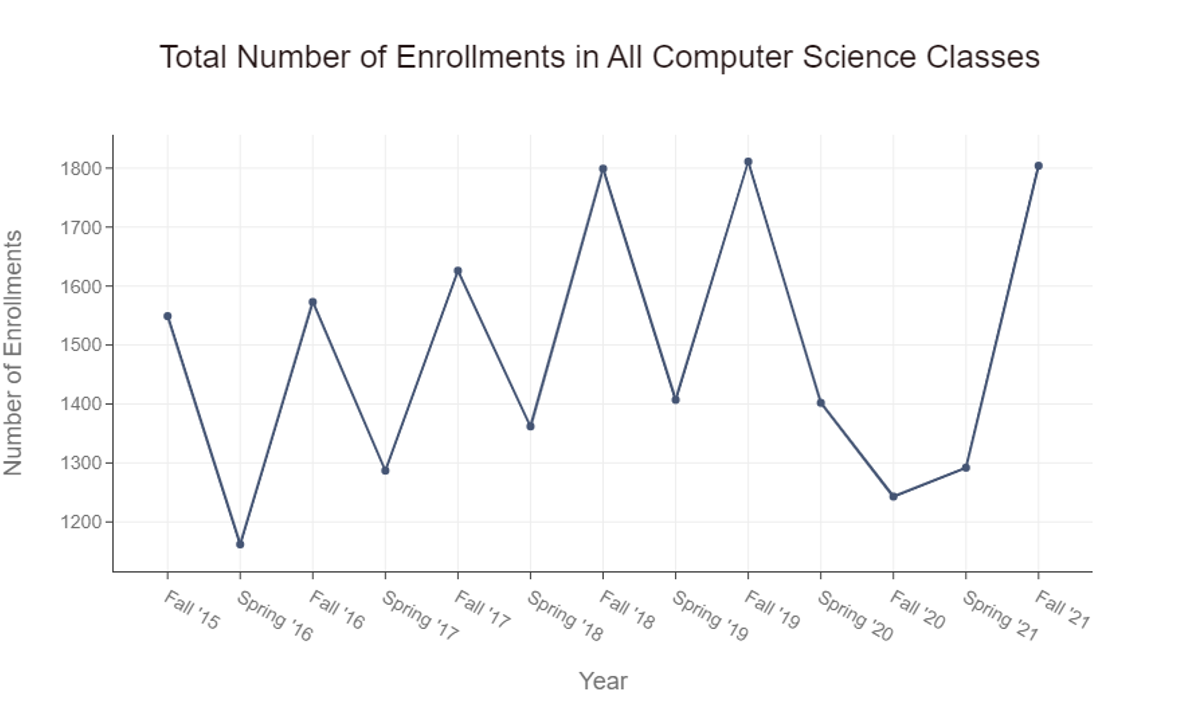 Total enrollment count across all offered Computer Science department courses, with records starting from Fall 2015
Total enrollment count across all offered Computer Science department courses, with records starting from Fall 2015Our analysis begins in Fall 2015 because Computer Science was not registered as a Course Department in the Enrollment Records until 2015, so there is less CS-specific enrollment data before that year. Although there appear to be large spikes in the data, this can be attributed to CS50, which is primarily offered in the fall and is consistently one of the highest-enrolled courses at the College. However, there still appears to be a steady rise in popularity for CS as a field of study since the start of these department records. To support that observation, we looked at the records of CS50 enrollment since 2011.
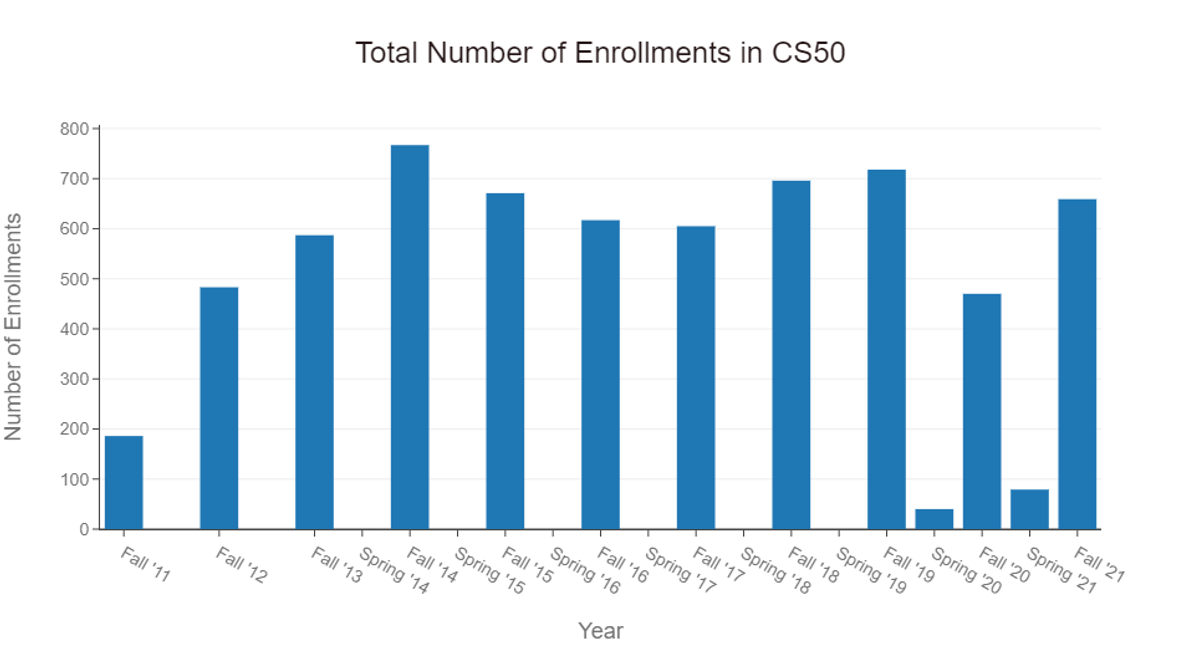 The enrollment count in CS50 from 2011 to 2021 (excluding Spring 2012 and Spring 2013)
The enrollment count in CS50 from 2011 to 2021 (excluding Spring 2012 and Spring 2013)CS50 enrollment was relatively small in Fall 2011, barely hovering below 200 enrollees. However, since then, CS50 has continued to reach about 600 enrollees since 2013. Even during the online 2020-2021 academic year, CS50 maintained a large enrollment of more than 450 students before jumping back above 600 in Fall 2021, our most recent in-person semester. The resilience of CS50’s enrollee population proves that CS has gained considerable popularity and traction within the College.
One intriguing observation to note is the large drop in general enrollment in CS classes during the 2020-2021 pandemic year. One would think that high-tech fields like CS, which can be done digitally for the most part, would have become more popular during an online academic year. Evidently, CS course enrollment was not immune to the difficulties of virtual learning and drop in the undergraduate population.
Another factor to be considered that may explain the increase in CS50 enrollment over the past 5 years is the course’s YouTube channel. The channel’s most popular videos are recordings of CS50 lectures that date back to 2017 or 2018, so this may explain the small increase in enrollment from the period 2017-2019.
Economics Enrollment
Economics, boasting the largest number of concentrators in the 2019-2020 year, has a very surprising history of enrollment since 2011.
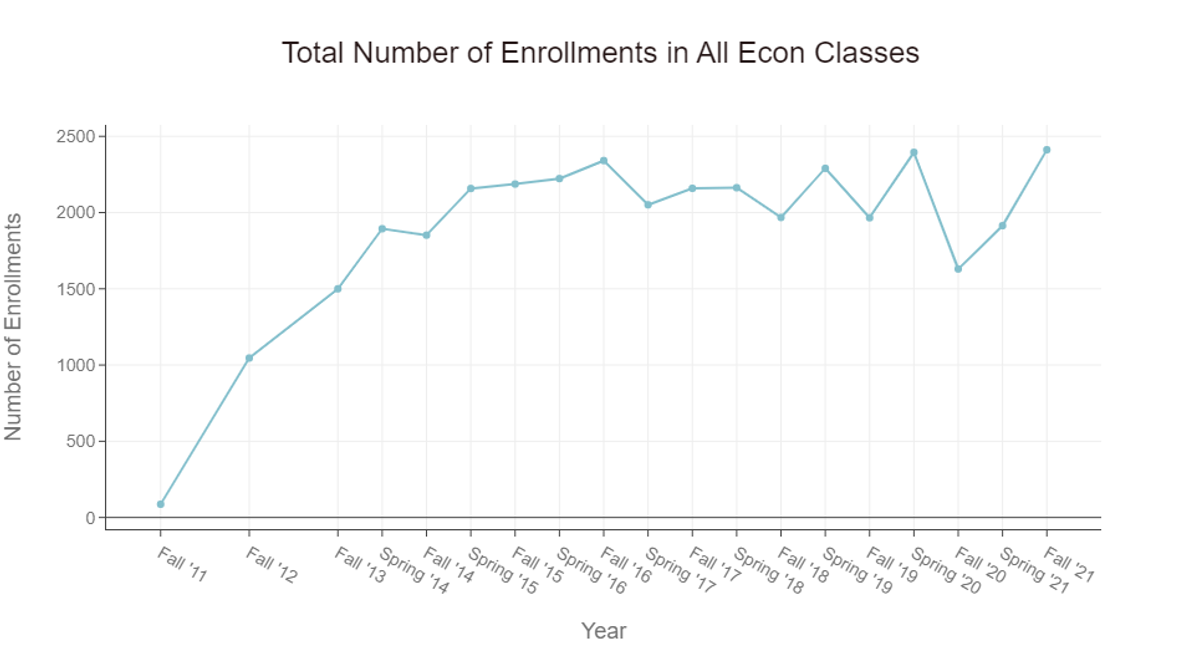 The total enrollment count across all offered Economics department courses
The total enrollment count across all offered Economics department coursesBased on the graph, the 87 total enrollees in Econ classes in 2011 seems miniscule compared to the shocking spike in Econ course enrollment in the following years. Economics continues to be an extremely popular field, bouncing back from the expected drop in enrollment in the pandemic year; Spring 2020 and Fall 2021 saw almost the same level of enrollment. The Ec10 series, which comprises the introductory economics courses that started as one Ec10 course before being split into Ec10a and Ec10b, is a significant reason why Economics enrollment data appears this way.
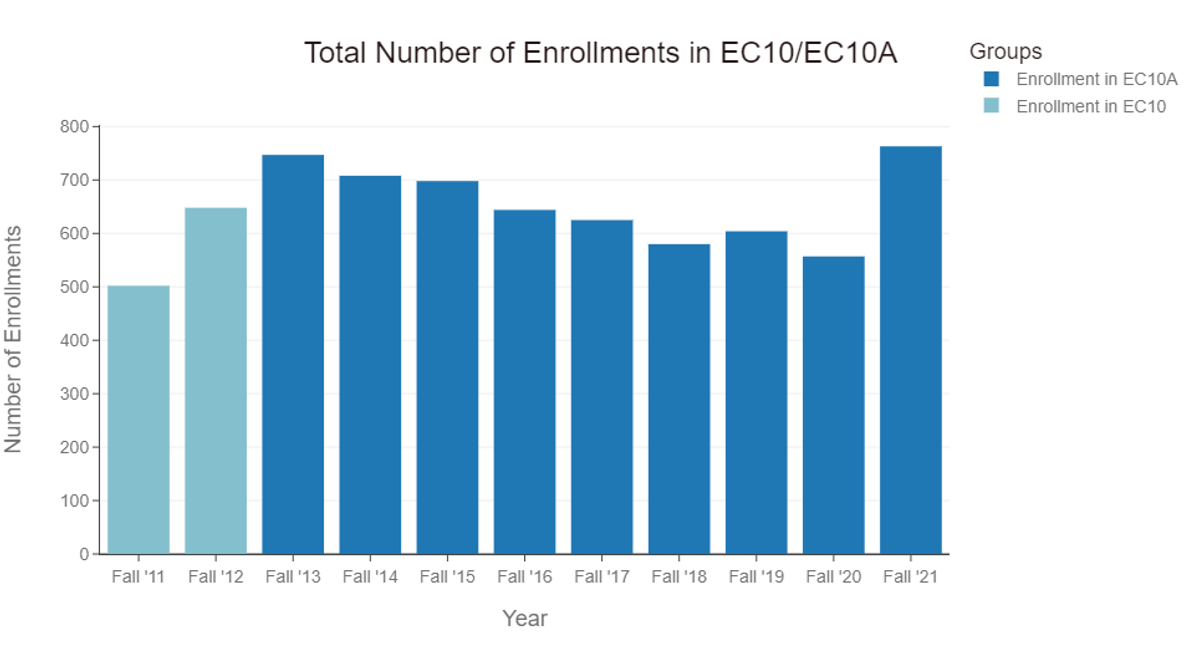 The enrollment count in Ec10 and Ec10a from 2011 to 2021
The enrollment count in Ec10 and Ec10a from 2011 to 2021This data shows that at the very least, introductory Econ has been consistently popular even as far back as 2011. The reason why Economics seemed so unpopular in the General Enrollment data is because Ec10 was categorized as a Core Curriculum course instead of part of the Econ department. After its transition into the department, Ec10 has contributed to the increased popularity of Economics concentration for the past decade. The concentration becomes even more popular as greater numbers of undergraduates take Ec10 and higher level Econ courses.
Conclusion
At Harvard, it is a natural question to ponder which subjects garner the most concentrators. In the case of Economics and CS, these two concentrations have continued to be very popular over the past decade, although their growth has slowed in recent years. Despite the drop in enrollment in namesake classes such as CS50 and Ec10 in Fall 2020, they were both able to rebound when Harvard students moved back on-campus in Fall 2021. With in-person classes back in session, the resilience of their popularity goes to show that these two fields will continue to be all the rage in the coming years.
Linked here is our dataset with raw data, cleaned data, and analysis: Enrollment Trends Deepnote
